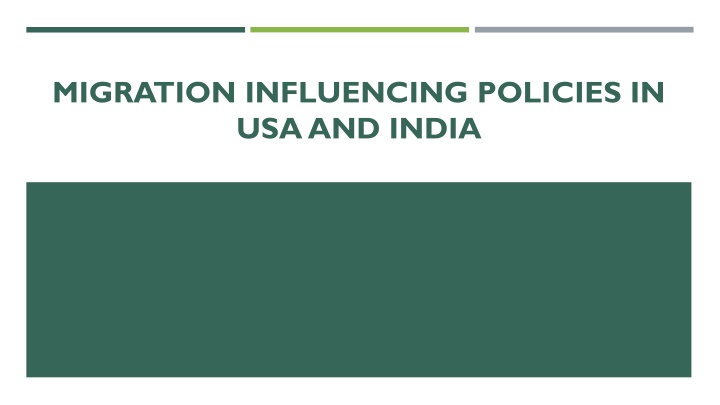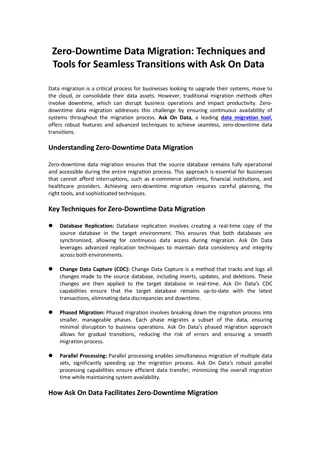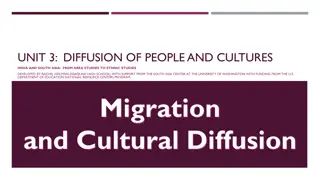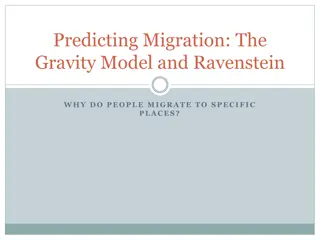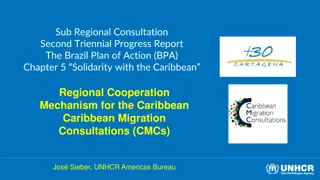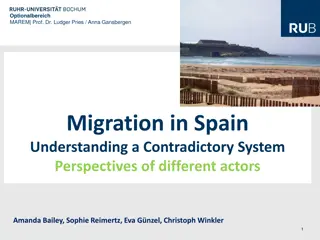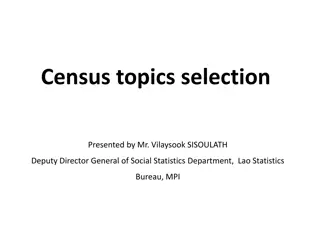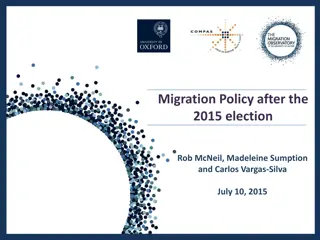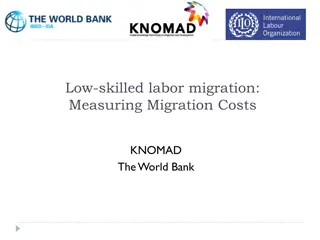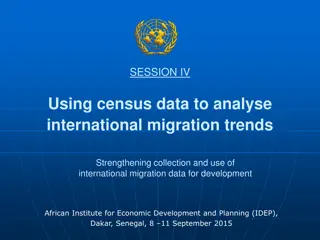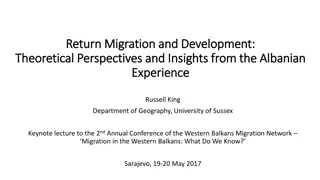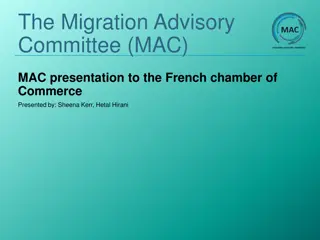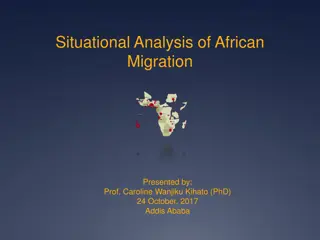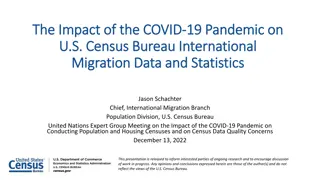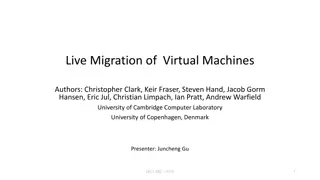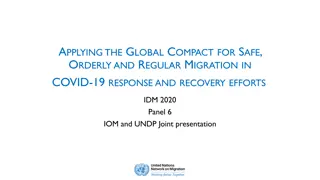International Migration Policies in USA and India: Trends and Impacts
International migration is a growing global phenomenon, with countries like the USA and India facing various challenges and opportunities. This article discusses the trends in international migration, the influence of migration policies in the USA, and the top countries hosting international migrants. It highlights the role of migration policies in shaping population growth, labor market needs, and cultural transformations.
Download Presentation

Please find below an Image/Link to download the presentation.
The content on the website is provided AS IS for your information and personal use only. It may not be sold, licensed, or shared on other websites without obtaining consent from the author.If you encounter any issues during the download, it is possible that the publisher has removed the file from their server.
You are allowed to download the files provided on this website for personal or commercial use, subject to the condition that they are used lawfully. All files are the property of their respective owners.
The content on the website is provided AS IS for your information and personal use only. It may not be sold, licensed, or shared on other websites without obtaining consent from the author.
E N D
Presentation Transcript
MIGRATION INFLUENCING POLICIES IN USA AND INDIA
INTRODUCTION International migration is a global phenomenon that is growing in complexity,scope and impact. Today, most countries are simultaneously countries of origin, destination and transit of migrants, so that countries in both less and more developed regions face various challenges and opportunities associated with migration. Migration policies play an important role in determining the flow, conditions and consequences of international migration.
TRENDS IN INTERNATIONAL MIGRATION In 2013,the number of international migrants worldwide reached 232 million,up from 154 million in 1990.Currently,the global population of international migrants is growing at about 1.6 % per year (World population growth rate is 1.1 %) Major regions of the world account for different shares of the global stock of immigrants and emigrants. In 2013, Europe hosted 31 percent of the global migrant stock, whereas it was the origin of 25 percent of all emigrants (of whom 65 percent were living within Europe). In comparison, Asia and Northern America hosted 31 and 23 percent of the global migrant stock respectively,while they were the origin of 40 and 2 percent of all emigrants. *(The number of international migrants is defined as the mid-year (1stJuly) estimate of the number of people residing in a country other than that in which they were born) *(An international migrant is defined as any person who changes his or her country of usual residence (UNDESA); International Stocks are defined as the total number of international migrants present in a given country at particular point in time (UNSD,2017)
MIGRATION POLICIES (USA) About 20 percent (45.8 million *Total International Migrant Stock 232 million, 2013*) of all international migrants reside in the United States,which as a country accounts for less than 5 percent of the world s population. This fact makes it ample clear that it is the largest magnet of international immigrants helped by some migration policies. Immigration policies generally respond to labour market needs and demographic objectives and destination countries. Historically, in America the immigration policies were influenced by both but recently it is influenced more by the needs of the labour market requirements.
Top Five Countries with Highest Number of International Migrants, 2011 Sl. No. Country No. of International Migrants (in Million) 1 USA 45.8 2 Russian Federation 11.0 3 Germany 9.8 4 Saudi Arabia 9.1 5 UK/UAE 7.8 Source: UN, Wold Population Policies Database
Immigration has shaped the United States as a nation. Lawful immigration has been a major source of population growth and cultural change throughout much of the US history because the United States is a settler colonial society, all Americans, with the exception of the small percent of Native Americans, can trace their ancestry to immigrants from other nations around the world. Although,immigration has occurred throughoutAmerican history,large scale immigration has occurred during just four peak periods: The peopling of the original colonies i. Westward expansion during the middle of the 19thcentury ii. The rise of cities at the turn of the 20thcentury iii. The fourth peak begins in the 1970s and continues today. iv. The guiding principles, and different ways to immigrate to the United States were largely established by the 1965 Immigration and NationalityAct and take place through three primary immigration streams.They are Family (re)unification for U.S.citizens and lawful permanent residents (LPR or Green Card holders) with close family members; i. Meeting legitimate labour market needs;and ii. Refuge for those in need of humanitarian protection. iii. The most common ways to immigrate are through the family-based or employment-based channels.
MIGRATION INFLUENCING POLICIES (INDIA) Globally, in 2013 India had the largest number of emigrants (14.2 million) suggesting India s experience of international migration is more of an emigration than immigration, therefore, the discourse too will focus on emigration. Emigration generates both opportunities and challenges for sending countries,especially in less developed regions. On the one hand, concerns have often been raised about the loss of human resources, including highly skilled workers, the so-called brain drain , which may hinder development in countries of origin (in the 1960s and 1970s India had such fears). On the other hand some countries in less developed regions view emigration as a strategy to boost development, not only from remittances or through alleviation of labour market pressures, also by recognizing that their diaspora can contribute to development through financial investmens in home countries, as well as through transfer of knowledge and skills (India in contrast to the 1960s and 1970s maintain such perspective today).
Sl. No. Country No. of Emigrants (in millions) 1 India 14.2 2 Mexico 13.2 3 Russian Federation 10.8 4 China 9.3 5 Bangladesh 7.7 Source: UN, World Population Policies Database
Two distinct types of labour migration have been taking place from India since independence: People with technical skills and professional expertise migrate to countries such as the USA, Canada, UK and Australia as permanent migrants (since the early 1950s) i. Unskilled and semi-skilled workers migrate to oil exporting of the Middle East on temporary contracts, especially following the oil prices increase of 1973-74 and 1979. ii. India has the world s largest diaspora, according to figures from the United Nations that show the destination of Indian migrants has shifted in the past two decades away from the US towards countries in the Middle East (West Asia) mostly to work as manual labourers and domestic staff. India s vast diaspora sends back millions of dollars in remittances every year with estimated remittance flows of around 72 billion dollars in 2015 made the South Asian nation highest receiving cash than any other country from its expats according toWorld Bank.
Top five destination of Indian emigrants Sl. No. Destination Country/Region No. in millions (Indian Emigrants) 1 UAE (West Asia/Middle East) 3.5 2 USA 2 3 Saudi Arabia (West Asia/Middle East) 1.9 4 Europe 1.2 5 Kuwait (West Asia/Middle East) 1 Source: un.org (International migrant stock, 2015)
POLICY REGIME GOVERNING INTERNATIONAL LABOUR MIGRATION FROM INDIA The overseas employment policy regime in India mainly addresses temporary and contract migration. The most important policy instrument, the Emigration Act 1983, deals with the emigration of Indian worker for overseas employment on a contractual basis and seeks to safeguard their interest and ensure their welfare. An examination of the provisions of the Emigration Act indicates the overseas employment policies in India have been largely confined to ensuing that the terms and conditions of employment conformed to certain specified norms so that agencies and employers did not subject the workers to exploitation. Efforts to manage and direct export of manpower have indeed been minimal. The policy regime has also not been concerned with migration of persons with technical or professional qualifications. The EmigrationAct has considerably reduced the problems encountered by migrant workers. However, there is little policy influence on the forces of market supply and demand which still largely determine the emigration of workers from India.
